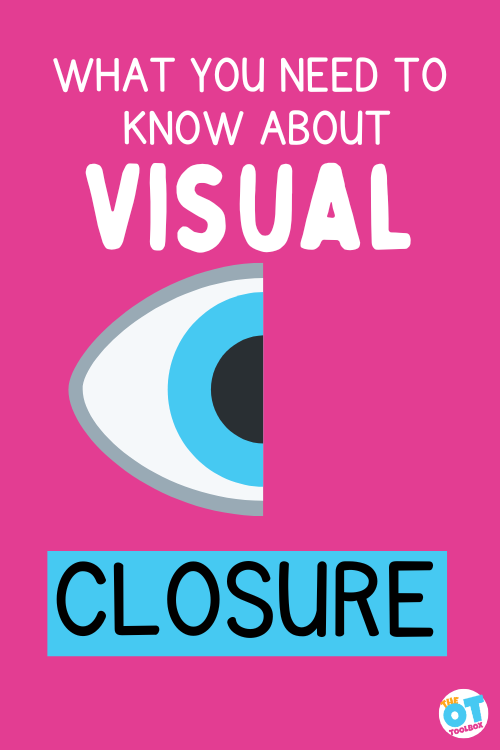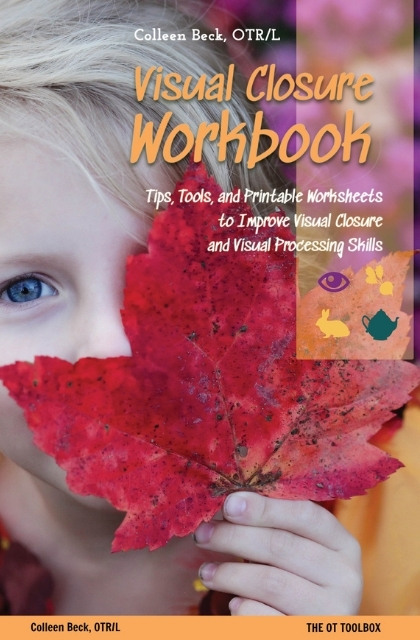It’s possible that you’ve heard the term visual closure before as this is a common visual skill that impacts learning, reading, and math skills. But did you know that visual processing skills also impact fine motor skills. Occupational
therapists assess and treat visual skills as one of the underlying contributors to functional deficits. Visual closure is just one of those visual perceptual skills that impact everyday tasks.
In this post will we discuss how visual closure is utilized in daily life, red flags for dysfunction, and some great activities to develop this skill.

What is Visual Closure
Visual closure refers to the brain’s ability to complete a picture or visual representation using incomplete information. This is a visual perceptual skill and a component of visual processing that enables us to visually fill in the blank with missing information.
This visual perceptual skill allows us to see part of an object and visualize in our “mind’s eye” to determine the whole object. When we see part of an item, we use visual closure to know what the whole item is. This skill requires the cognitive process of problem solving to identify items.
This visual perceptual skill is the one used to locate and recognize items in a hidden picture puzzle. In written work, we use visual closure to recognize parts of words and letters when reading and copying work.
Visual Closure is defined as the ability of the eyes to visualize a complete image or object when only a portion is seen. An individual can see just part of a letter or number when reading and recognize how to write that figure. We can read a word or sentence without focusing on each letter and how it is made.
Visual Closure is an essential skill for many tasks. It is a skill that enables us to recognize a friend when it their face is partially covered by a scarf. It allows us to identify a road sign that is hidden by tree branches. It allows us to read, write, spell, complete math, and manage many other daily tasks.
Visual Closure enables us to look at an incomplete form and abstractly fill in the missing details in order to identify the form or shape. The skill allows us to comprehend portions of visual information without actively assessing each detail in isolation. This skill is one that utilizes abstract problem-solving skills.
Visual closure is a skill we use all day long.
From learning, to driving, to getting dressed, we use this aspect of visual perception in discerning between both familiar items and unfamiliar objects in every environment.
Visual closure takes into consideration spatial relationships, orientation in space, and knowledge about similar objects. In this way, both visual memory and working memory plays a role in recognizing a familiar item previously filed away in the brain’s knowledge.
Perceptual skills like vision closure allow us to function in day to day tasks, use safety awareness, and complete everyday activities through visual motor integration.
Visual perception is just one of many functions of the body that OT practitioners can address in therapy to improve quality of life.
Examples of Visual Closure
We are able to visually close an incomplete image when we see part of an item partially obscured by other items in the environment.
Some examples of visual closure include:
- Recognizing that a complete object is in front of us even when part of it is covered up
- Identifying a stop sign even when it’s partially obscured by a tree branch
- Knowing that a complete fork is in the tray of utensils when we see only a portion of the fork
- Realizing the approximate size of objects when part of it is blocked from our vision
- Using the ability to make inferences about an object’s size even when portions are blocked from our line of sight
- Realizing the complete whole of an object is still there even when obscured, for example: knowing a window continues behind a curtain.
- Reading a word with fluency and effiencey, as well as reading comprehension (more on all of these areas below)
- Needed skill for spelling and sight word recognition
- Required to help figure out a shape or form that is partially hidden
- Needed to recognize an object when only a portion is visible
- Necessary skill for identifying spelling mistakes or incorrect information in written work
- Required to visually locate partially hidden objects in a busy background
- Required skill for reading words or recognizing words that are partially visible
Visual perception involves a complex set of skills, including one that we will highlight here: visual closure. This important cognitive ability involves being able to understand and interpret incomplete or abstract visual information. In other words, it’s the ability to see an object or figure in your mind’s eye when only a part of it is actually visible. Pretty cool, right?
WHY IS Vision CLOSURE USEFUL?
Visual closure is a type of visual perception skill that allows you to understand the whole shape of an object, even if part of it is hidden.
For example, we use this skill to recognize a letter of the alphabet when part of it is erased. Many students would recognize a visual closure worksheet without knowing it – they often look like one half of a familiar shape, and the student must draw the remaining half to create the whole the shape.
They may also use this skill during a color-by-number worksheet, where they can recognize an image appear before it is even complete!
This is an important skill as it increases our ability to understand the world and adapt to changes. Having strong vision skills also increases your overall visual cognitive performance, leading higher reading and writing abilities. It also sets you up for success for finding lost keys or quickly locating a spice in the cabinet.
Visual Closure and Reading
When it comes to vision, there is a lot that goes into reading and writing. Understanding the visual differences between letters, visually connecting the form of a letter to a sound, and stringing single letters into words (and then sentences) involves coordination of visual processing and multiple skill areas. When a child picks up a pencil to write the daily homework assignments into a tracker or completes a math page, the visual processing system is going into overdrive with scanning, visual tracking, visual motor integration, and visual perceptual skill work.
In the classroom, we often times run into many students who struggle with reading. Parents may notice a difficulty with reading during homework or other reading tasks. When a child struggles with keeping their place when reading a line of text, has difficulty recognizing words they should know, struggles with reading fluency or reading comprehension, a visual processing issue may be at the center of the struggle.
One necessary foundation skill needed for reading fluency is visual closure. While it may not seem like the most predictable culprit of the visual perceptual skills that impact reading, vision closure certainly is at play.
Visual closure is a skill used when reading. These visual skills are used to visually complete the word in the mind’s eye without reading each letter. This is similar to word prediction technology. The mind is able to predict the word based on letters, and context. This enable reading fluency as well as reading comprehension.
Visual closure is one skill that allows us to recognize words without focusing on each individual letter within a word. It allows us to glance at a sight word and read the word quickly. It enables us to comprehend a reading passage with fluency and efficiency as we visualize and discern words. It allows us to read and discern words that have similar beginnings or endings.
When a child looks at words and sentences, they typically are able to fill in missing parts of information. They can predict what is coming when reading sentences, copy words if they don’t see the whole word, solve puzzles, and fill in worksheets. When visual closure and predicting information or self-correcting missing information is difficult, kids don’t recognize errors in reading, writing, and math.
Similarly, visual closure enables us to identify a word without perceiving each specific part of the letters which make up a word. It is easy to see how a child who struggles with this visual perceptual skill can labor at reading!
VISUAL CLOSURE RED FLAGS
How do I know if there is an issue with my visual closure abilities? There are signs that can indicate visual closure problems in children.
These are common red flags associated with poor visual closure in kids:
Children with difficulties in visual closure may have trouble completing mazes, puzzles, or worksheets. They might have difficulty identifying items that are partially obscured by other items, such as finding a serving spoon or a matching sock hidden in a draw full of items. They might have difficulty with spelling or math tasks or concepts.
- Difficulty recognizing letters or reading in certain fonts
- Often poorly forms letters while writing
- Not being able to recognize a word that is partially hidden
- Difficulty completing words with missing letters
- Requires extra time to read because they must sound out each letter in a word rather than seeing the whole word
- Unable to find an object when it is partially covered (ex: milk in the fridge or a shirt in a drawer)
- May find puzzles too challenging
- Figuring out how to put together toys with multiple parts
- Difficulty interpreting visual information, such as maps or diagrams
Please note that this is list not exhaustive, nor does it by any means diagnose someone with visual or cognitive deficits. It is here it give you an idea of what it may look like or feel like to have impaired visual closure understanding.
Since we know that various visual perception skills match these red flags, we have the perfect resource for you: this Visual Closure Workbook! This workbook gives an in-depth look at a very specific aspect of visual perception, it gives ample ways to identify it, and provides various levels of interventions with fun themes to go along.
Visual Closure ACTIVITIES & GAMES
The good news is that there are tons of fun ways to develop visual closure skills! Below you can find activities, games, books, and activities you can do with objects at home to build visual skills.
Books to Develop Visual Closure
Here are a few easy activities that you can do at home to help:
Puzzles: Jigsaw Puzzles are a great way to work on this skill, as they require children to use their visual and spatial awareness skills to figure out how the pieces fit together. Start with simple puzzles and gradually increase the difficulty as your child improves.
Picture Matching: Cut out a set of pictures and have your child match the incomplete pictures to the complete ones. For example, you can cut out a picture of a house, leaving only the roof and part of the walls visible. Your child’s job is to find the matching picture of the whole house.
Printable Worksheets: Visual Closure worksheets can be a tool to support development of this visual processing skill. We love creating resources that build this area of development in various themes. We have fun downloads here on the website that targets visual closure.
Hidden Objects: Provide your child with a few objects and something like a blanket to cover parts of them. Have them use their visual closure skills to figure out what’s missing or covered up.
Drawing: Encourage your child to draw from memory. For example, you can show them a picture for a few seconds, then have them close their eyes and draw what they remember. This activity helps to develop their visual closure skills, as well as their memory and creativity.
Children with strong visual closure skills are better able to complete puzzles, read and write, and interpret their surroundings. On the other hand, children who struggle with vision closure may have difficulty with these tasks and may require extra support and intervention.
Dot to Dot Activities- Completing a connect the dot activity is a great way to develop visual closure skills by working on seeing the bigger picture. Best of all, these visual perception activities support development of other underlying areas, too: visual figure ground, visual scanning, form constancy, and the ability to complete a partial picture.
If you notice your child struggling with this skill, consider seeking out the help of an occupational therapist. With the right support and activities, your child can develop their visual closure skills and improve their overall functioning.

Sydney Thorson, OTR/L, is a new occupational therapist working in school-based therapy. Her
background is in Human Development and Family Studies, and she is passionate about
providing individualized and meaningful treatment for each child and their family. Sydney is also
a children’s author and illustrator and is always working on new and exciting projects.
The Visual Closure Workbook is a 65 page digital file designed to impact visual perceptual skills for reading comprehension and efficiency, and the ability to visualize a complete image or feature when given incomplete or partial information. With functional visual closure skills, we are able to determine
This visual perceptual skill resource includes:
- Information on visual processing and visual closure
- Tips and tools to address visual closure needs
- A thorough explanation of visual closure and what problems in this area look like in everyday tasks
- Reproducible worksheets and activity lists
- Activities to grade visual perceptual skills in hands-on activities
- 3 levels of worksheet pages in a variety of themes







